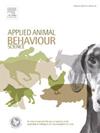Effects of training of Saanen goats for the first milking on behavior, milk yield, and milk quality traits
IF 2.2
2区 农林科学
Q1 AGRICULTURE, DAIRY & ANIMAL SCIENCE
引用次数: 0
Abstract
This study aimed to assess the effects of prepartum milking training of primiparous goats on behavior, plasma cortisol concentration, and milk yield and quality traits. Thirty-one primiparous Saanen goats were assigned into two treatments: CT = milking-trained (n = 16) and ST = not milking-trained (n = 15) goats. Milking training consisted of the handler entering the pen where the goats were and walking calmly among them for 20 minutes/day for seven days, and then driving the goats to the milking parlor, positioning them in the stanchion, and gently touching their ribs, legs, and udders for five minutes for seven days. Behavioral assessments were carried out measuring the latency that each goat took to get close to a known person (voluntary approach = LC) and the flight distance (FD) before training (BT), just after training (AT), at the beginning (between days five and seven, d5–7) and 30 days of lactation (d30). Milking reactivity was assessed by recording the step-kick (SK) and head, ear and tail movement (MOV) scores. Plasma cortisol concentrations (PCC) were measured after milking. All measurements were recorded at 5–7 (d5–7), 30 (d30), and 60 (d60) days of lactation, defining the assessment days. The number of animals that required restraint during milking was also recorded. Milk yield was recorded daily throughout the 120 days of the lactation period, and milk quality traits (dry matter, density, fat, protein, lactose, minerals, acidity, SCC, Staphylococcus and total bacterial count - TBC) at d5–7, d30, d60, d90, and d120. The goats’ reactivity decreased throughout lactation. CT goats showed a lower LC on d30 than before training. PCC showed higher values on d60 than prepartum. At the beginning of lactation, 73 % of ST goats were restrained for milking, while for CT goats, 45 %. Milk yield was highest in the period from 8 to 90 days of lactation and 0.5 kg/day higher (although not significant) in CT than in ST. Milk quality traits showed significant differences between assessment days, except for TBC and Staphylococcus counts. In conclusion, the training protocol did not significantly impact goats' reactivity during milking, PCC, and milk quality traits. However, there was a tendency to increase milk yield and reduce the number of animals restrained during milking.
训练萨能山羊首次挤奶对其行为、产奶量和牛奶质量特性的影响
本研究旨在评估初产山羊产前挤奶训练对其行为、血浆皮质醇浓度、产奶量和牛奶质量性状的影响。31 只初产萨能山羊被分为两个处理:CT = 接受过挤奶训练的山羊(n = 16),ST = 未接受过挤奶训练的山羊(n = 15)。挤奶训练包括:饲养员进入山羊所在的圈舍,在山羊中间平静地走动,每天20分钟,持续7天;然后将山羊赶到挤奶厅,将它们放在挤奶台上,轻轻触摸它们的肋骨、腿和乳房,持续5分钟,持续7天。行为评估是在训练前(BT)、训练后(AT)、泌乳初期(第五天和第七天之间,d5-7)和泌乳 30 天(d30)测量每只山羊接近已知人的潜伏期(自愿接近 = LC)和飞行距离(FD)。挤奶反应性通过记录步踢(SK)和头、耳、尾运动(MOV)得分进行评估。挤奶后测量血浆皮质醇浓度(PCC)。所有测量均记录在泌乳 5-7 (d5-7)、30 (d30) 和 60 (d60) 天,即评估天数。此外,还记录了挤奶过程中需要束缚的动物数量。在泌乳期的 120 天内,每天记录牛奶产量,并在第 5-7 天、第 30 天、第 60 天、第 90 天和第 120 天记录牛奶质量特性(干物质、密度、脂肪、蛋白质、乳糖、矿物质、酸度、SCC、葡萄球菌和细菌总数 - TBC)。山羊的反应性在整个哺乳期都有所下降。与训练前相比,CT 山羊在第 30 天的 LC 值较低。PCC山羊在第60天的LC值高于产前。在泌乳初期,73% 的 ST 山羊在挤奶时受到约束,而 CT 山羊只有 45%。泌乳期 8 至 90 天的产奶量最高,CT 比 ST 高 0.5 千克/天(尽管不显著)。除 TBC 和葡萄球菌计数外,牛奶质量性状在不同评估日之间存在显著差异。总之,训练方案对山羊挤奶时的反应性、PCC和牛奶质量性状没有显著影响。不过,有增加产奶量和减少挤奶期间受限动物数量的趋势。
本文章由计算机程序翻译,如有差异,请以英文原文为准。
求助全文
约1分钟内获得全文
求助全文
来源期刊

Applied Animal Behaviour Science
农林科学-行为科学
CiteScore
4.40
自引率
21.70%
发文量
191
审稿时长
18.1 weeks
期刊介绍:
This journal publishes relevant information on the behaviour of domesticated and utilized animals.
Topics covered include:
-Behaviour of farm, zoo and laboratory animals in relation to animal management and welfare
-Behaviour of companion animals in relation to behavioural problems, for example, in relation to the training of dogs for different purposes, in relation to behavioural problems
-Studies of the behaviour of wild animals when these studies are relevant from an applied perspective, for example in relation to wildlife management, pest management or nature conservation
-Methodological studies within relevant fields
The principal subjects are farm, companion and laboratory animals, including, of course, poultry. The journal also deals with the following animal subjects:
-Those involved in any farming system, e.g. deer, rabbits and fur-bearing animals
-Those in ANY form of confinement, e.g. zoos, safari parks and other forms of display
-Feral animals, and any animal species which impinge on farming operations, e.g. as causes of loss or damage
-Species used for hunting, recreation etc. may also be considered as acceptable subjects in some instances
-Laboratory animals, if the material relates to their behavioural requirements
 求助内容:
求助内容: 应助结果提醒方式:
应助结果提醒方式:


